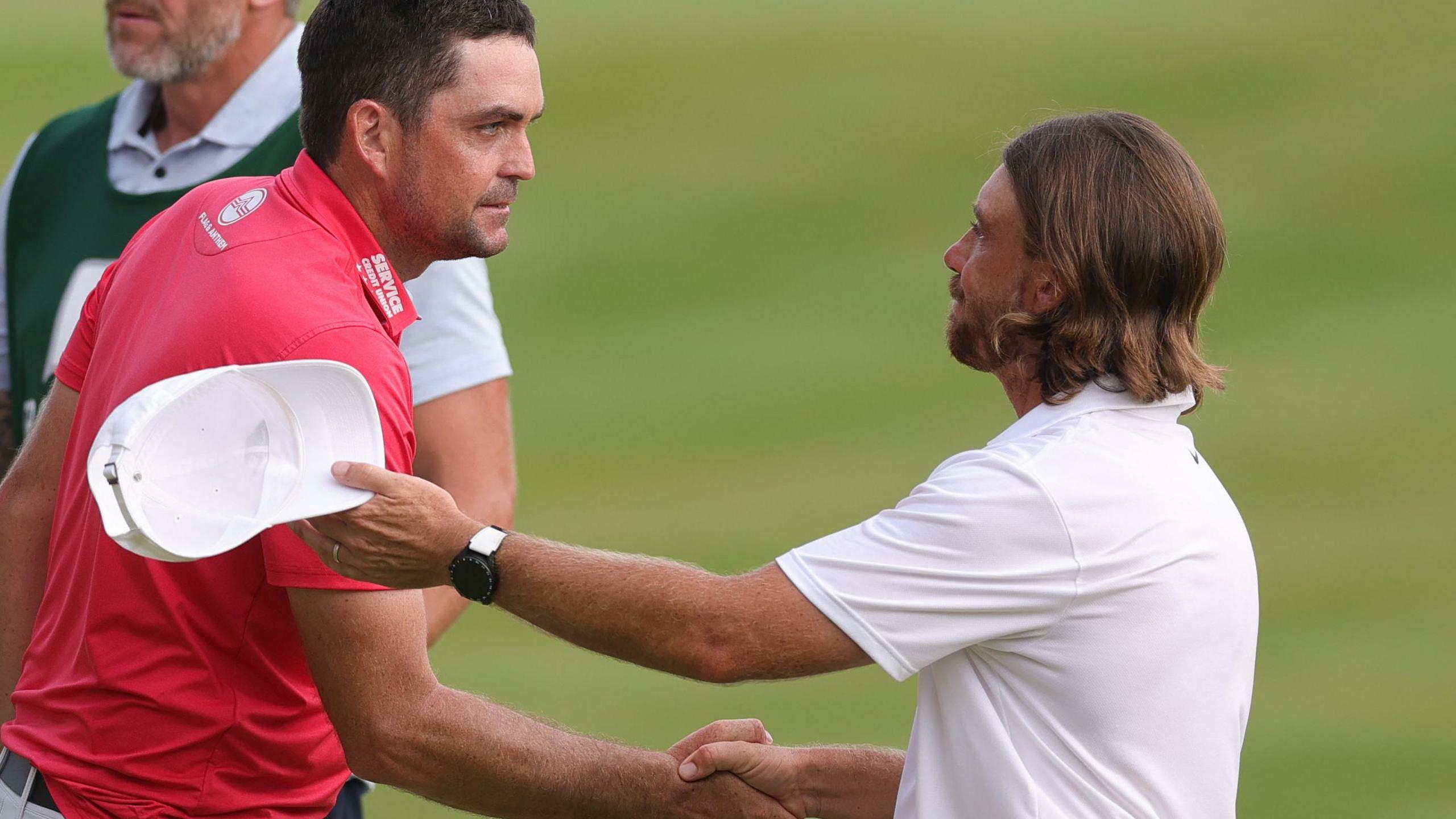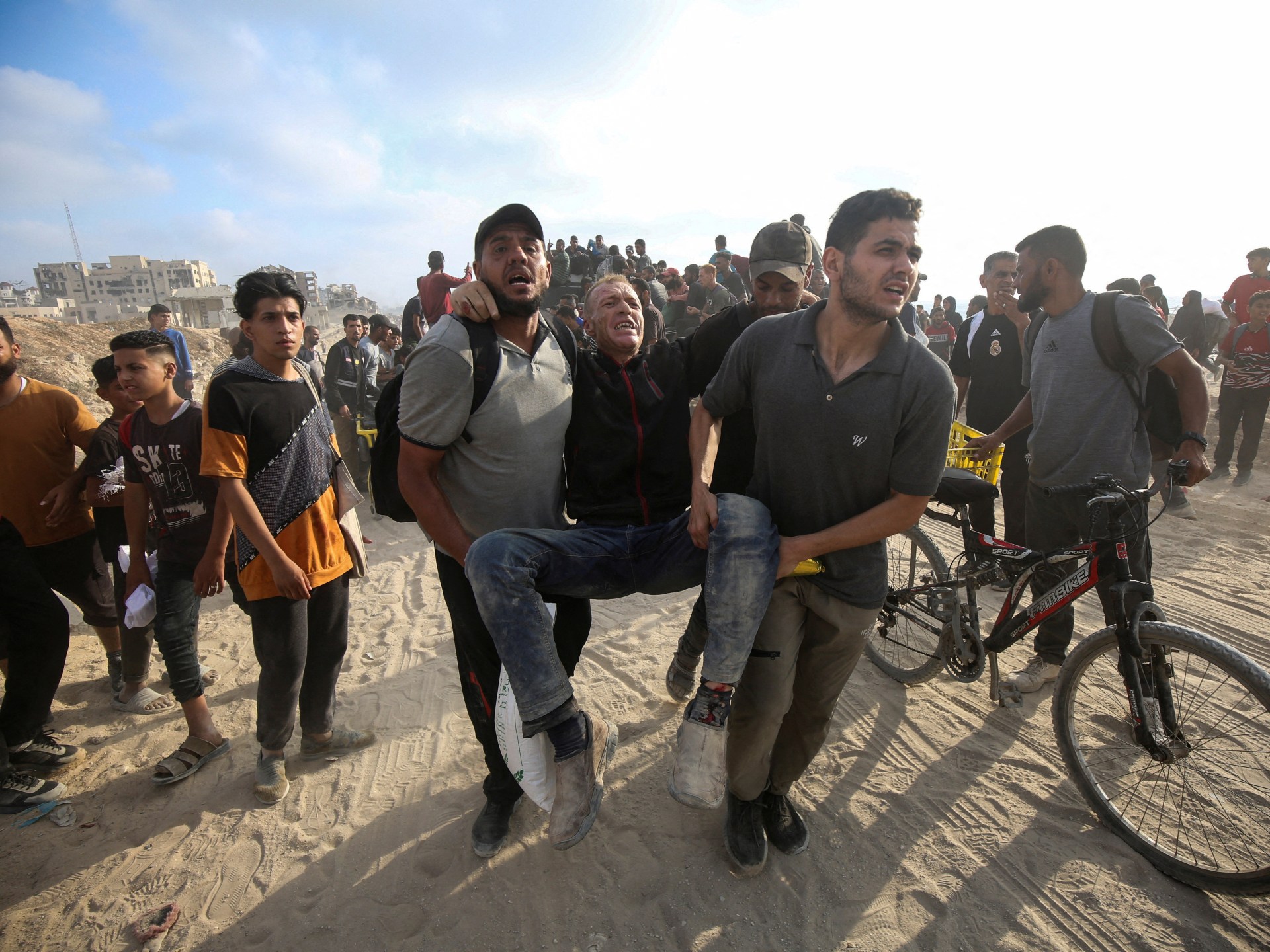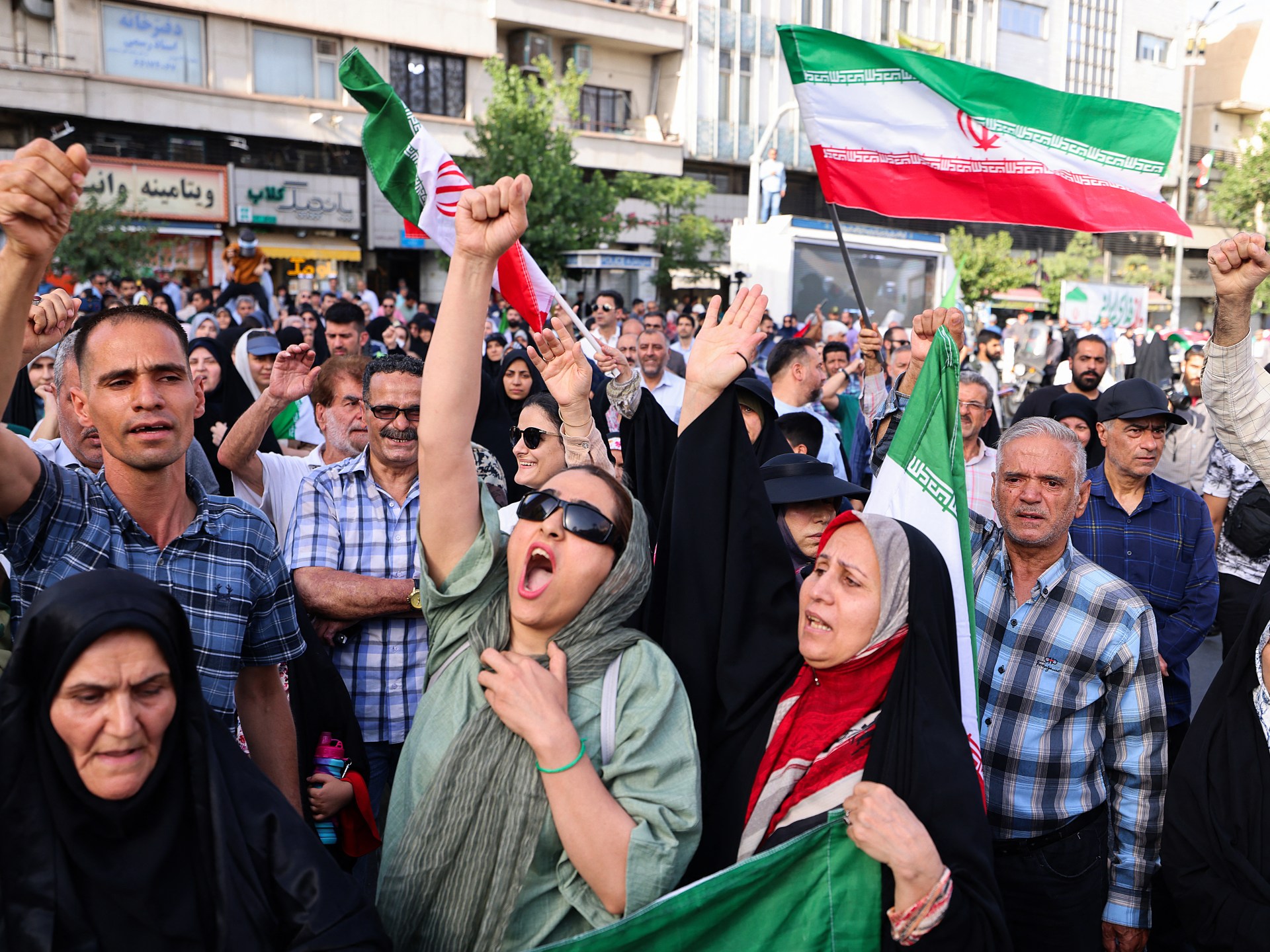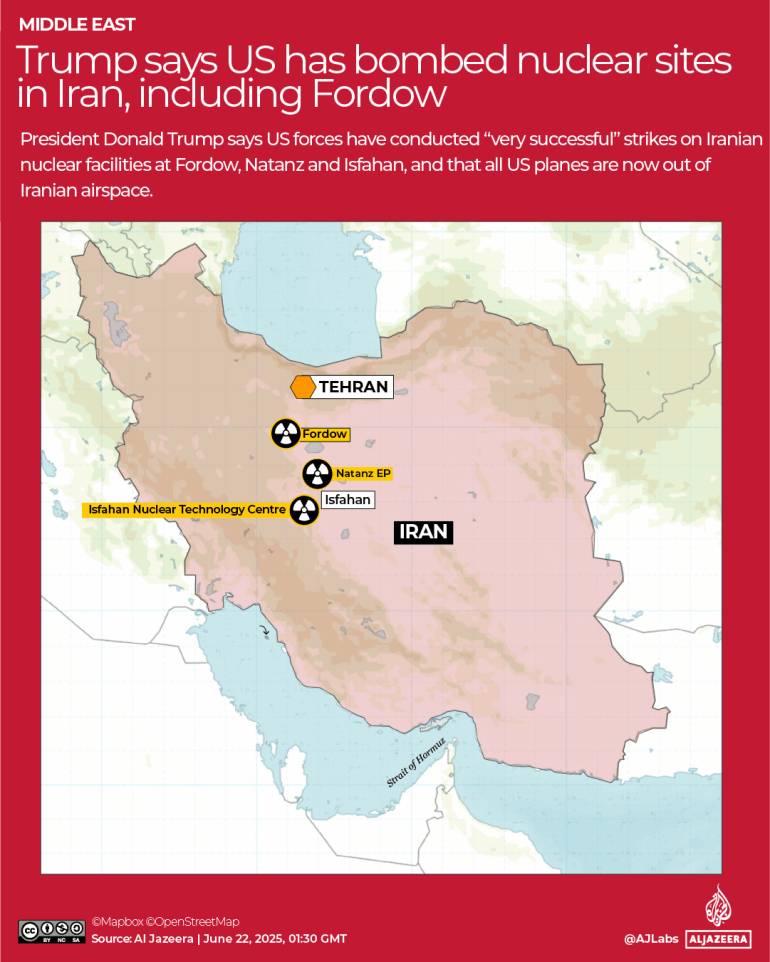Early on Sunday, the United States bombed three Iranian nuclear sites after more than a week of Israeli strikes on Tehran’s military and nuclear sites, stoking concerns about radiation leaks and contamination in Iran and neighbouring countries in the region.
US President Donald Trump said the US strikes “obliterated” key nuclear enrichment facilities at Fordow, Natanz and Isfahan. So far, no increase in radiation levels has been detected outside the targeted sites.
But the United Nations nuclear watchdog, the International Atomic Energy Agency (IAEA), has warned of chemical contamination inside these facilities. And experts have said that any attack on Iran’s only operating nuclear power plant, Bushehr, could lead to a major radiation crisis.
Here is what we know about the potential of radiation risk and contamination in Iran and the region:
What do we know about the Israeli attack on the Fordow site?
The Israeli army attacked Iran’s Fordow nuclear site a day after it was targeted in US strikes, according to a spokesman for the Qom province crisis management headquarters.
Morteza Heydari provided no further details regarding the attack, but said “no danger is posed to citizens” in the area.
Following the attacks on three nuclear sites, including Fordow, Trump claimed “monumental damage’ to the nuclear sites. “Obliteration is an accurate term!” he posted on his Truth Social platform.
On Monday, Rafael Grossi, the head of the IAEA, said “very significant damage” is expected at the Fordow site. While “no one, including the IAEA, is in a position to have fully assessed the underground damage at Fordow”, he said it is expected to be “very significant”.
That’s because of “the explosive payload utilised and the extreme vibration-sensitive nature of centrifuges”, Grossi said at an emergency meeting of the IAEA’s board of governors.
Did the US attacks cause radioactive contamination?
In the aftermath of Sunday’s attack, levels of radioactivity in Iran and nearby countries are normal, confirmed their governments and the IAEA, which noted that no off-site radiation has been reported.
In a statement on Sunday, the IAEA said that the Isfahan site, which was previously also struck by Israel, had sustained additional damage after the US strikes.
The IAEA said that any radioactive contamination caused at Isfahan is limited to the buildings that were damaged or destroyed.
“The facilities targeted today either contained no nuclear material or small quantities of natural or low-enriched uranium, meaning any radioactive contamination is limited to the buildings that were damaged or destroyed,” the agency said.
Grossi, the IAEA chief, said that the US strikes on Isfahan hit several buildings, including some “related to the uranium conversion process” while a fuel enrichment plant was hit at Natanz.
Grossi said IAEA inspectors stand ready to check the targeted facilities “when agreed with Iran”.
The IAEA monitors and reports nuclear activities of Iran through inspections, monitoring equipment, environmental sampling, and satellite imagery, according to a UN website news release.
Why did radiation remain at normal levels?
There are multiple possible reasons why the radiation has stayed at normal levels.
One is that Iran had moved away its nuclear infrastructure in anticipation of an earlier Israeli strike. Mahdi Mohammadi, an adviser to Iran’s parliament speaker, Mohammad Bagher Ghalibaf, said earlier that Iran had moved its nuclear infrastructure from Fordow in anticipation of an attack.
So far, only enrichment sites, where uranium is enriched to make atomic bombs, have been hit.
At enrichment sites, uranium exists in gaseous form, which combines with fluoride gas to form uranium hexafluoride. This is spun around in centrifuges to increase the amounts of uranium-235, the isotope that can support nuclear fission chain reactions.
Hence, if struck, uranium hexafluoride might leak out of enrichment sites. The fluoride gas is deadly when inhaled and can be corrosive to the skin.
Moreover, enrichment facilities are also fortified underground and buried hundreds of metres deep, making them difficult to damage and hence lessening radiation risks.
On the other hand, nuclear reactors primarily use uranium. In a nuclear reactor, the fission chain reaction needs to take place within a fraction of a second, leading to a nuclear explosion from the tremendous amount of energy released. Typically, 90 percent enrichment is needed to make an atomic bomb.
Why are experts warning against attacking the Bushehr plant?
Concerns have particularly been raised against attacks on the Bushehr nuclear site, with the IAEA chief warning of a disaster if the plant located at Iran’s Gulf Coast is hit.
Grossi said on Thursday that a direct hit to Bushehr, which is monitored by the IAEA, would result in a “very high release of radioactivity to the environment”.
Grossi added that Bushehr contains “thousands of kilogrammes of nuclear material”. In a worst-case scenario, it would require evacuation orders to be issued for areas within several hundred kilometres of the plant, including population centres in other Gulf countries, he said.
The IAEA chief said that a strike on the two lines that supply electricity to Bushehr could cause its reactor core to melt, with dire consequences.
Authorities would need to take protective actions including administering iodine to populations and potentially restricting food supplies, with subsequent radiation monitoring covering distances of several hundred kilometres.
On June 19, the Israeli military said that it had attacked Bushehr, but later said that the announcement was a mistake.
Bushehr, which is located around 750km (465 miles) south of Tehran, is Iran’s only commercial nuclear power plant. It is run by uranium produced in Russia.
Bushehr, home to around 223,504 people, has two large nuclear reactors – one of them still under construction.
“It would be very dangerous if it were hit with a bomb or the cooling systems are interrupted,” Robert Kelly, a former IAEA inspector who has worked in Iraq, South Africa and Libya, told Al Jazeera.
“You might get an accident on the scale of Fukushima, where the reactor would melt down inside its building and maybe release small amounts of gas to the environment,” Kelly said.
In March 2011, a magnitude 9 earthquake and tsunami disabled the power supply and cooling systems of three reactors at the Fukushima Daiichi nuclear power plant, located in Okuma on Japan’s east coast. Radioactive material was released from the site, leading to tens of thousands of people being evacuated.
A UN report deems Fukushima the largest civilian nuclear accident since that in Chernobyl, Ukraine in 1986.
“If somebody attacks the town of Bushehr, it may not be the reactor. So when people are saying they’re attacking Bushehr or attacking the reactor of Bushehr, it could be the one that’s not finished yet,” Kelly said.
“I think the Russians would have a lot to say about someone attacking the facility that they already built and the one that’s worth about $7bn that isn’t finished yet. I think Israel has to take the Russians into account in this case, too.”
Russian state news agency RIA reported that the head of Russia’s nuclear energy corporation Rosatom, Alexei Likhachev, warned: “If there is a strike on the operational first power unit, it will be a catastrophe comparable to Chernobyl.”
Why are Gulf States worried?
A strike on Bushehr would contaminate a critical source of desalinated potable water for Gulf countries, including Qatar.
Qatar and Bahrain are 100 percent reliant on desalinated water for drinking water. All of Bahrain’s groundwater is saved for contingency plans.
In March, Qatar’s Prime Minister Sheikh Mohammed bin Abdulrahman bin Jassim Al Thani said during an interview with US media personality Tucker Carlson that Qatar had conducted simulations of an attack on Bushehr. The Qatari PM revealed that an attack on the plant would leave the Gulf entirely contaminated and Qatar would “run out of water in three days”.
The United Arab Emirates (UAE) is reliant on desalinated water, which accounts for more than 80 percent of its drinking water.
In Saudi Arabia, around 50 percent of the water supply came from desalinated water as of 2023, according to the General Authority for Statistics.
While countries like Saudi Arabia, the UAE and Oman have access to other water sources, Qatar, Bahrain and Kuwait do not have other options.
Kelly said that the nuclear reactors are extremely tough and are designed to melt down inside their containment in certain accident situations.
“The idea that very much of the material inside is going to get out is actually pretty small, so I think people are maybe obsessing too much,” he said.




